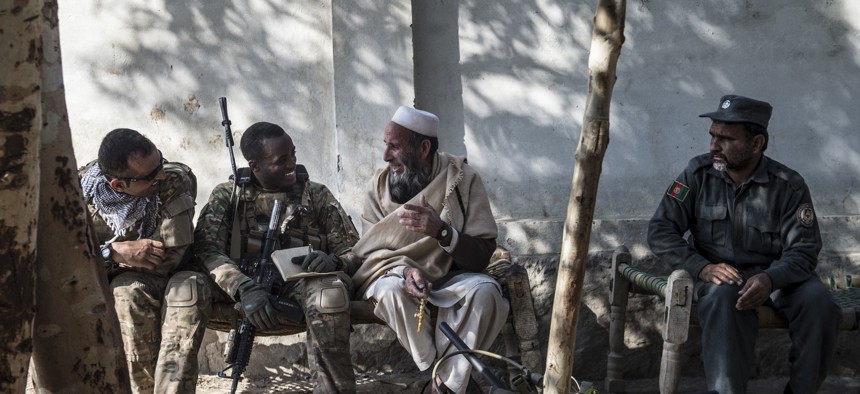
A U.S. Army soldier talks with an Afghan village elder during a key leader engagement outside of Camp Fenty, Afghanistan, Feb. 18, 2016. Staff Sgt. Corey Hook/U.S. Air Force
It Takes a Village to Raze an Insurgency
As the Trump Administration reviews its counter-terrorism policies and strategies, it should apply the lessons of the Village Stability Operations program.
Over the last few years, the U.S. military’s special operations community has changed the way it approaches counterinsurgency. Along with direct action — think Navy SEALs helicoptering in to find Osama bin Laden or Army Green Berets clearing buildings of insurgents —Special Operations Forces are now much more prone to work with indigenous security forces, empowering them to fight on their own behalf. Instead of security being something done to local populations, it is increasingly something done with them.
This dramatic shift is largely an outgrowth of a rising view within the U.S. military that however effective unilateral U.S. combat operations may be against terrorist and insurgent groups, these “victories” will only be temporary absent a viable local partner who is motivated to fight. But this approach isn’t focused simply on raising local security forces, it also requires confronting an insurgency’s political strategy as well as participating in modest state-building efforts.
This turnabout in SOF strategy took place for many reasons, but a central factor was lessons learned in fighting the Taliban. After years of combat in Afghanistan, Special Operations Forces began to realize that relentless clearing operations were unsustainable; for security to endure, local communities had to be involved and participate in their own defense. Special Operations Forces also discovered that Afghan villagers were motivated by a variety of reasons to join the Taliban insurgency, many of which had nothing to do with the Islamist movement’s religious ideology. Some villagers joined due to tribal and village frictions, others because they were disappointed by the Karzai government, were intimidated into joining, or were simply seeking a steady paycheck. The Taliban itself continued to exist because the Afghan state was either too weak to defend local communities or too overbearing, preying on its own people and alienating many from their government. What was becoming clear to SOF was that the United States and the Afghan government had to confront the Taliban insurgency holistically, addressing its political, tribal, and economic aspects as well as its military wing while undertaking modest efforts to nurture the Afghan state and ensure that it governed justly. In a sense, the United States had to use the Taliban’s structure and strategy against it.
In 2010, U.S. Special Operations Forces launched the Village Stability Operation program, an innovative approach in Afghanistan. At the time, the Taliban’s main strength was its ability to mobilize the population, both by capitalizing on popular grievances against the government and by raw intimidation. The new approach teamed Army Special Forces and Navy SEALs with villagers to fight the Taliban comprehensively. Instead of constantly clearing villages, U.S. forces would now have a “persistent presence”; instead of engaging in direct combat, the United States would support Afghans’ own fight by building Afghan Local Police forces; and instead of using a top-down approach to build stability, the United States would add a bottom-up, grassroots effort as well.
This new strategy, which eventually involved over 30,000 Afghan Local Police protecting more than 115 districts, proved incredibly effective. The Taliban were increasingly unable to access the population physically, appeal to their grievances to separate them from the government of Afghanistan, or entice them to fight through economic incentives. By enlisting Afghans in their own defense, organizing the local populace, and addressing their grievances with the Afghan government, SOF was able to defeat the local Taliban politically as well as militarily.
As the Trump Administration reviews its counter-terrorism policies and its strategies in Afghanistan and Iraq, it should seek to apply the lessons of the Village Stability Operations program. Just as the Taliban did — and does —ISIS and al-Qaeda mobilize local populations through intimidation and persuasion, and build governing structures to entice communities to their banners or to control them.
The United States must fight the enemy’s strategy, not just his military forces in oder to be successful in these kinds of conflicts. Local communities must be organized not just to defend themselves militarily, but to build resilient governing structures at the grass roots and to foster dynamic communities that can resist terrorism. Efforts must also be made to link these communities to their governments, which must be taught and encouraged to be legitimate, capable, and effective. Working by, with, and through indigenous forces and their government is a long-term strategy for success, just as a relentless focus on fighting directly with U.S. forces is a recipe for endless war.